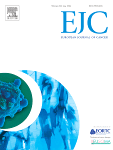
Publication date: November 2017
Source:European Journal of Cancer, Volume 86
Author(s): Tomonari Kinoshita, Chie Kudo-Saito, Reiko Muramatsu, Tomonobu Fujita, Miyuki Saito, Haruna Nagumo, Toshiharu Sakurai, Shinobu Noji, Emi Takahata, Tomonori Yaguchi, Nobuo Tsukamoto, Yuichiro Hayashi, Kaoru Kaseda, Ikuo Kamiyama, Takashi Ohtsuka, Kenji Tomizawa, Masaki Shimoji, Tetsuya Mitsudomi, Hisao Asamura, Yutaka Kawakami
We have previously demonstrated that the prognostic significance of tumour-infiltrating CD8
+ T cells significantly differs according to histological type and patient smoking habits in non-small cell lung cancer (NSCLC). This work suggested that infiltrating CD8
+ T cells may not be activated sufficiently in the immunosuppressive microenvironment in non-smokers with adenocarcinoma. To understand the immunogenic microenvironment in NSCLC, we characterised immune cells comprehensively by performing an immunohistochemical evaluation using an alternative counting method and multicolour staining method (n = 234), and assessed immune-related gene expression by using genetic analytical approaches (n = 58). We found that high infiltration of activated CD8
+ T cells expressing interferon gamma (IFN-γ) and granzyme was correlated with postoperative survival in patients with non-adenocarcinoma. On the contrary, CD8
+ T-cell accumulation was identified as a worse prognostic factor in patients with adenocarcinoma, particularly in non-smokers. Infiltrating CD8
+ T cells were significantly less activated in this microenvironment with high expression of various immunoregulation genes. Potentially immunoregulatory CD8
+ FOXP3
+ T cells and immunodysfunctional CD8
+ GATA3
+ T cells were increased in adenocarcinoma of non-smokers. CD4
+ FOXP3
+ regulatory T cells expressing chemokine receptor-4 (CCR4)- and chemokine ligand (CCL17)-expressing CD163
+ M2-like macrophages also accumulated correlatively and significantly in adenocarcinoma of non-smokers. These characteristic immune cells may promote tumour progression possibly by creating an immunosuppressive microenvironment in non-smoking patients with lung adenocarcinoma. Our findings may be helpful for refining the current strategy of personalised immunotherapy including immune-checkpoint blockade therapy for NSCLC.
from Cancer via ola Kala on Inoreader http://ift.tt/2yjQCwQ
via
IFTTT
